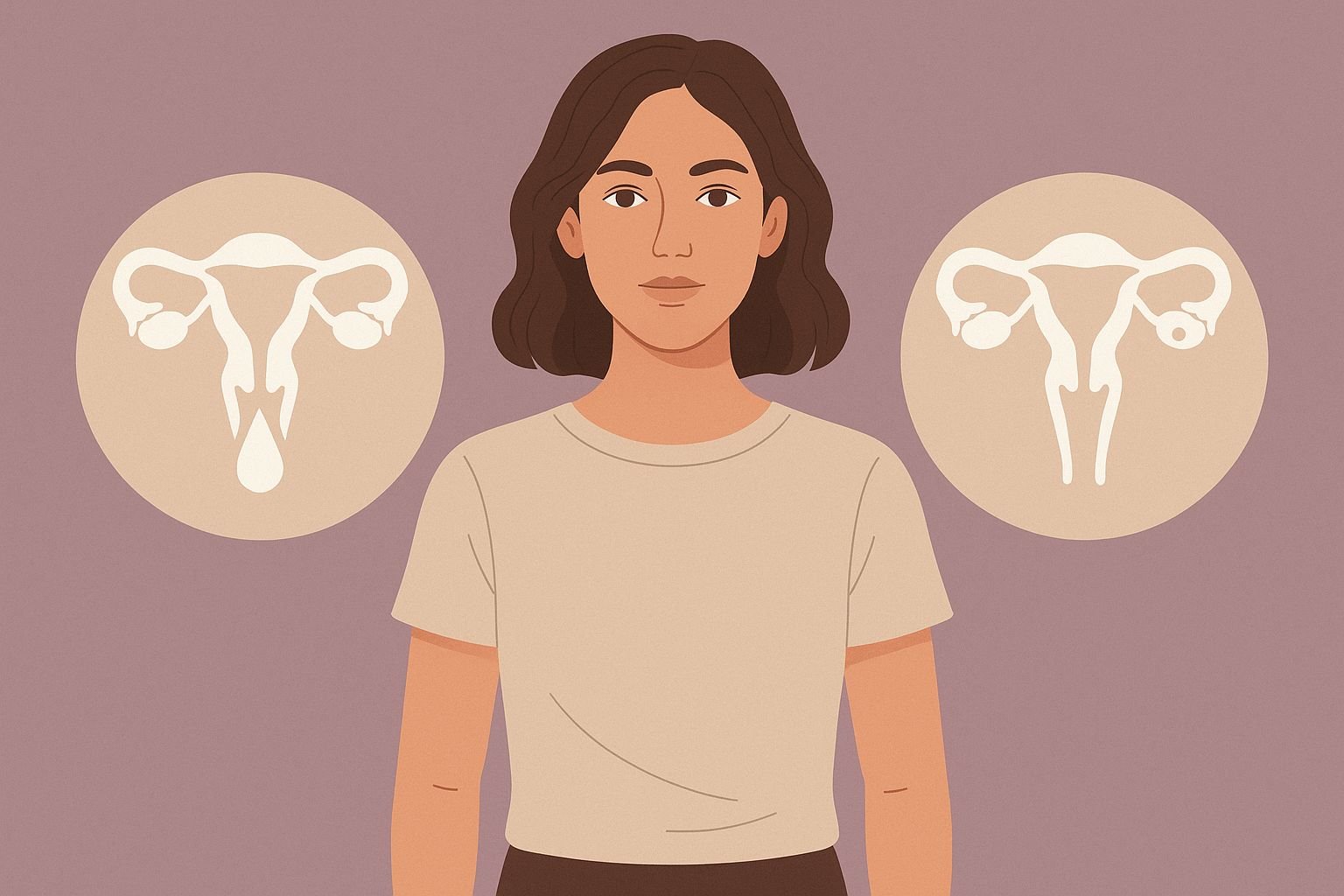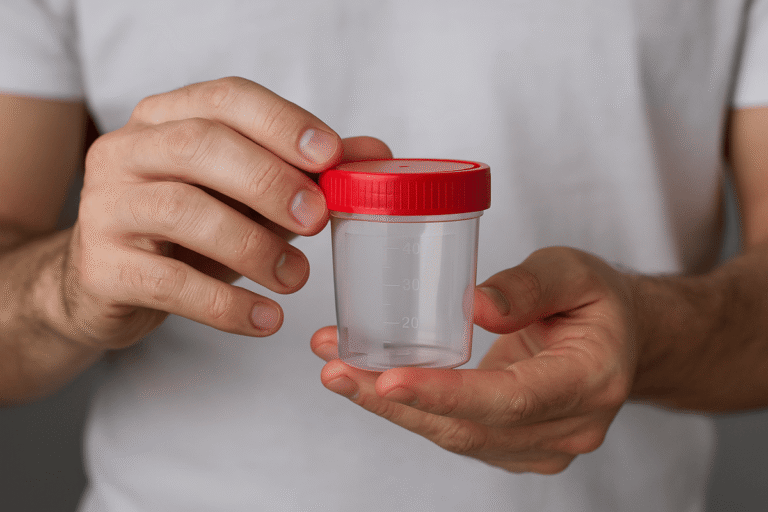It’s a common, slightly confusing experience — you notice some discharge a few days before your expected period. But then a little voice in the back of your mind whispers, “Could this mean I’m pregnant?” You’re not alone. Many women find themselves in this oddly specific moment, caught between what they think they know about their cycle and what might be something else entirely.
Cervical mucus, after all, plays a significant role in your reproductive system, not just as a background process, but often as one of the first hints that something might be happening inside your body. The problem is that discharge can look pretty similar whether it’s just PMS or the early signs of pregnancy. So let’s take a closer, realistic look at what each might feel or look like — and where the line between the two starts to blur.
Also read: How to Take Emergency Contraceptive Pills to Avoid Pregnancy
First: A Quick Refresher on Cervical Mucus
Discharge, or cervical mucus, changes throughout your menstrual cycle. Most of these changes are regulated by hormones such as estrogen and progesterone. Depending on where you are in your menstrual cycle, the texture, color, and amount of discharge can vary significantly.
You might notice creamy, white discharge after ovulation, or more transparent, stretchy fluid when you’re fertile. And sometimes, around the time your period is due, things dry up or get a little thicker. It’s not an exact science for everyone — some women see patterns they can track like clockwork. Others, not so much.
This baseline is important because it provides a reference point for comparing any changes. If you know what your “normal” looks like, then spotting a shift becomes easier. But if your cycles are unpredictable or you’re not really in the habit of checking — well, that’s where things get tricky.
Discharge Before Period: What’s Normal?
Before your period starts, your body’s progesterone levels peak. Progesterone is what maintains the uterine lining in case of pregnancy, but if fertilization doesn’t happen, it eventually drops, triggering menstruation.
During this pre-period phase (called the luteal phase), discharge tends to:
- Become thicker or stickier
- Be white or off-white
- Sometimes, even a little yellowish (but not necessarily a sign of infection)
- Feel drier than during your fertile window
You might notice less discharge overall. Some women even say it’s almost non-existent right before their period begins. There could also be a slightly sour or musky smell — not offensive, just different. That’s all part of the hormonal shift.
And sometimes, it’s a mixed bag. One month, you might notice more discharge than usual; the next, barely any. Stress, sleep, diet — all of it plays a part.
Also read: What Is Female Orgasmic Disorder?
Early Pregnancy Discharge: What’s Different?
Now, this is where things get interesting. If an egg is fertilized and implants in the uterus, your hormone levels shift again, rapidly. Estrogen and progesterone both rise significantly, and this sudden change can alter your discharge almost immediately, sometimes even before a pregnancy test turns positive.
What you might see:
- Creamy, white, or milky discharge (sometimes called leukorrhea)
- Increased amount — you might notice it enough to change underwear more often
- Slight odorless or mild-sweet smell
- Consistent moisture — it doesn’t dry up like it typically does before a period
One thing many women say is that the discharge feels… persistent. As in, it doesn’t taper off like it might before a period. It stays steady or even increases slightly. For some, this change happens just a few days after ovulation — for others, it’s more subtle.
Now, here’s the frustrating part. This type of discharge is very similar to what some women experience during their luteal phase. The creamy texture? The white color? Not precisely a giveaway. You see where the ambiguity lies.
Can Implantation Bleeding Be Mistaken for Discharge?
Another confusing element: implantation bleeding. Some women experience light spotting around 6 to 12 days after ovulation, right around the time they might expect PMS symptoms. It’s usually pink or brown and may be mixed with discharge.
Naturally, this can be alarming. You think, “Is this the start of my period?” However, it doesn’t progress in the same way as a regular period. Instead of heavy flow, it stays light or disappears altogether.
If your discharge is tinted with a tiny bit of brown or pink around this time, and you don’t usually spot before your period, it could be an early pregnancy clue. But again — could is the operative word.
Also read: Ectopic Pregnancy Warning Signs You Should NEVER Ignore
Other Clues That May Help You Tell the Difference
Discharge is just one piece of the puzzle. When trying to distinguish between pre-period symptoms and early pregnancy signs, it’s helpful to consider the whole picture.
Here are a few other things to consider:
1. Timing
Discharge from pregnancy may begin around the time of implantation, which occurs about 6 to 10 days after ovulation, if you’re paying attention to your cycle and notice a sudden change in the mid-luteal phase, which might raise a flag.
2. Breast Sensitivity
Both PMS and pregnancy can cause tender breasts. But in pregnancy, the sensation might be a little more intense or different — more of a tingling or burning feeling around the nipples—still, not a guarantee.
3. Fatigue
This is tough to judge. PMS fatigue is real. However, if you feel unusually drained — such as falling asleep at 7 p.m. — that might be worth noticing.
4. Bloating and Cramps
Here’s where it gets even more tangled. Light cramping and bloating? It could be your period. Or it could be the uterus beginning to expand slightly due to early pregnancy.
In short, it’s all… annoyingly similar.
When to Take a Test
If you’re playing the guessing game with your discharge and symptoms, you’re probably just a few days away from your expected period. A home pregnancy test can usually detect HCG (the pregnancy hormone) as early as 10–12 days past ovulation, though waiting until the first day of your missed period gives more accurate results.
That said, if you’re tracking your discharge and things feel different, not just physically, but instinctively, it might be worth testing a bit earlier. Some women know something’s up, even before science can confirm it.
A Quick Personal Anecdote (Because This Happens Often)
I once spoke to someone who described her early pregnancy discharge as “weirdly creamy and… more than usual.” She thought it was just a strange PMS cycle, but something about it bugged her enough to test early. Sure enough — the test turned positive at 11 DPO.
On the flip side, another friend swore she was pregnant because her discharge had changed, and she felt nauseous. It turned out to be a late period brought on by stress. So — yes, it’s very possible to misread the signs.
So, What’s the Verdict?
Discharge alone can’t tell you if you’re pregnant. It can offer clues, sure. But unless you’re super familiar with your cycle and what’s “normal” for you, it’s easy to overanalyze every twinge and texture.
Here’s a rough guideline:
Feature Discharge Before PeriodEarly Pregnancy Discharge
Texture: Thick, sticky, or creamy. Creamy or milky, possibly more abundant
Color White or yellowish White or off-white
Amount tends to decrease , often increases, or remains steady
Smell : Slightly sour, Mild, or odorless
Duration Decreases before the period starts , and may persist past the missed period
But remember — none of these are definitive. You might not even notice any discharge changes at all, and still be pregnant.
Final Thoughts
Trying to decipher what your body is telling you is both empowering and exhausting. Discharge before a period and early pregnancy discharge are, quite honestly, so similar that sometimes it all feels like a guessing game.
That may be okay. You don’t have to get everything perfectly right. Your body is not a machine, and your instincts — while sometimes frustratingly vague — still count for something.
If you’re unsure, if something feels off, or if you’re just… curious, take a test. Give yourself peace of mind. Whether it’s PMS or pregnancy, what you’re feeling is valid and deserves your attention.





[…] especially true in the first trimester, when the urine is cloudy. This discharge is usually thin, white, or milky and doesn’t smell unpleasant. The cervix and vagina work together to keep the right […]